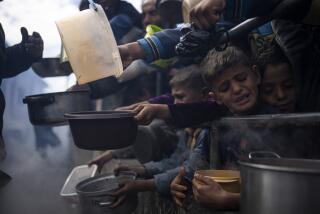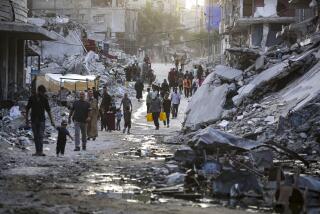Interview: For Gaza cooks, it’s two parts rice, one part defiance
Fiery peppers and searing spices heat up Gaza Strip cuisine, a fitting metaphor, perhaps, for the enclave’s place in the cauldron of Middle East strife.
Israeli troops have imposed a tight cordon around Gaza border crossings, sea access and airspace since the strip’s 2007 takeover by the militant Islamic group Hamas, crippling a fragile economy where nearly half the residents are jobless.
That means Gazans are confronted with daily challenges to put their signature foods on the family table: Locally made olive oil has disappeared, the once-resplendent olive groves blasted by artillery exchanges. The deep channel of migrating fish off the Mediterranean shore is now off limits. Even the red tahina that reflected Gazans’ unique way of toasting sesame seeds has faded into memory for many, a victim of import controls.
But cooks adapt. Rabbits and pigeons are raised in rooftop hutches to replace pricey lamb or chicken in the festive qidra casserole essential at any special dinner. Creative cooks have figured out how to craft the creamy jibna baladiya farmer’s cheese from powdered milk provided by aid agencies on which most of Gaza’s 1.7 million inhabitants depend.
In a salute to both Palestinians’ cuisine and their spirit of resistance, Gaza native Laila Haddad of Columbia, Md., and Madrid-based social activist Maggie Schmitt have produced “The Gaza Kitchen: A Palestinian Culinary Journey” (Just World Books, 139 pages, copyright 2013), a cookbook that chronicles the struggle to shore up a besieged culinary heritage. They spoke with The Times about their mission:
Q: What inspired this cookbook-cum-manifesto?
Haddad: Food is the last bastion of identity for Palestinians. We’ve lost almost everything else. Food has located us where maps failed to do so. But our identity is very vulnerable now. The idea of writing a book, using food as a narrative, really appealed to us as a unique and special way to discuss the situation there.
Q: Relate for us some of the stories you’ve been told by Gaza cooks from their experiences dealing with frequent power cuts and shortages.
Schmitt: It’s not that foods aren’t available. The problem is that people don’t have the capacity to buy it. Whether it’s coming through the border crossings from Israel or through the tunnels from Egypt, it gets in but at jacked-up prices.
Haddad: People find a way to manage. They can get what they want when they really need it. You see cattle being led through the tunnels around holidays, to provide meat for the traditional clay-pot dishes. Every household has a kitchen garden, even if it’s only a few pots on the window sill. You’d be hard-pressed to find a home without greenery planted, something fruitful. Even if they have only one square meter they will plant a lemon tree or olive tree.
Schmitt: One of the ingenious inventions of the strip are these little aluminum pot-ovens. There are coils inside the lid, so it is hot inside and also on the top of the cover. They heat up really fast, so even if the electricity goes out there’s enough heat to bake one little pita loaf inside and a second one on top, like on a griddle. There are also some communal ovens where people who can’t afford to heat the oven in their own home can come and bake their bread.
Q: What do they talk about when they gather around these communal ovens? Is it a place for venting over the hardships?
Haddad: One of the places we profile in the book is a women’s cooking cooperative, the Zeitun Kitchen, where 14 women gather and prepare food for catering to weddings and family gatherings. Many are the sole breadwinners of their families, supporting 15 or 16 people with what is a very meager income. But they work in such a joyous and uplifting mood. It’s a beehive of activity, with all of them moving about this one small room in 120-degree heat, working with a single stovetop. It’s always laughter, gossip about their husbands, advice on blood pressure remedies.
Q: What are the most painful casualties of the blockade, in terms of ingredients or products that are essential to Palestinian cookery but hard to keep in stock?
Haddad: You don’t find people using semolina in their baked goods anymore. The traditional cookies of Gaza are made of semolina, olive oil and date paste. Most people now substitute white flour, soybean oil and white sugar -- stuff you get in the aid distribution.
Schmitt: For most families, almost anything is pretty hard to make. Something like qitra, which requires meat and rice and spices and needs to be baked in a clay oven, it’s quite expensive. If someone is getting married or you’re having a funeral, it represents a gigantic effort to pull all of that together.
Q: Gaza is on the sea, but are its residents able to fish and harvest shellfish from the Mediterranean as they were years ago?
Schmitt: The fishing zone used to be 12 nautical miles but gradually and unilaterally that has been reduced. Now it stands at just three nautical miles, which is all relatively shallow water. Gaza historically relied on the deep-water trench that is nine miles off the coast, where the good fishing begins. But Gaza fishermen are now confined to the shore, where you can see the Israeli gunboats. They can’t risk exceeding the limit for fear of having their boats confiscated or provoking gunfire.
Haddad: One benefit, though, is that the limits have inspired the development of Gaza’s first freshwater fish farms. It was started by Iyad and Ziyad, “the Fish Brothers,” as we call them in the book. They mostly sell to donor organizations that distribute it to the needy, but it’s a booming business and has encouraged others to open fish farms.
Q: Is eating well the best revenge?
Haddad: I wouldn’t call it revenge. It’s a quiet, daily resistance, a steadfastness. It’s our declaration that we will insist on maintaining our humanity and dignity in spite of the circumstances.
More to Read
Sign up for Essential California
The most important California stories and recommendations in your inbox every morning.
You may occasionally receive promotional content from the Los Angeles Times.











